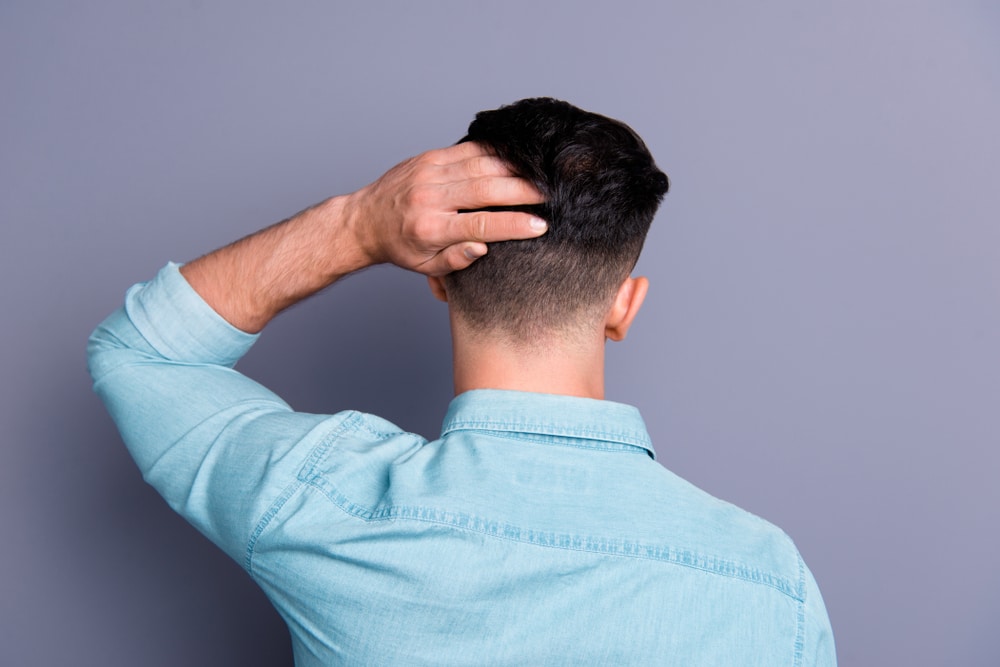As it is mentioned in the International Hair Restoration Surgery (ISHRS) site, (ishrs.org) hair transplant using the FUE technique (Follicular Unit Excision), is “one of two donor harvesting methods used to harvest the small follicular units.
With the FUE technique, follicular units are individually extracted from the patient’s donor area using a small round micro punch. It has gained popularity in recent years and is often described as a “minimally invasive” procedure because it does not involve stitches, and the tiny round excisions are left open to heal without sutures.
However, it must be noted that when thousands of small cuts are made in the skin, it is an invasive procedure and does constitute surgery. The actual transplantation occurs the same for both donor harvesting techniques, as the grafts are inserted using various tools and needles or micro blades into recipient sites (small incisions) in the areas where the patient has experienced hair loss.”
Hair transplant using the FUE technique can yield successful outcomes, given that certain conditions are met. It is essential to undergo the surgical procedure with an experienced and specialized hair transplant surgeon. However, it is important to exercise patience as it may take time for the final results to manifest. At Anastasakis Hair Clinic, you may expect an excellent outcome from a hair transplant using the FUE technique.
The Process of Hair Transplant Using the Fue Technique
In hair transplant using the FUE technique, follicular units are meticulously extracted one by one from the donor area, which is a region of permanent hair growth, usually at the back and the sides of the head. Unlike the FUT technique, there is no need for sutures in this procedure.
However, a light and inconspicuous scar, smaller than a millimeter in diameter, remains for each harvested hair follicle. This scar can be easily concealed by the surrounding hair. The key distinction between the hair transplant using the FUE and FUT techniques lies in the method of harvesting hair follicles. Nonetheless, the placement of the follicular units in the recipient area and all subsequent steps are carried out in the same manner in both technique
Hair Transplant Using the FUE Technique at Anastasakis Hair Clinic: Pre-operative Assessment.
The initial stage involves a precise and comprehensive diagnosis. Not every individual is suitable for hair transplant using the FUE technique. During the medical evaluation by Dr. Anastassakis, a detailed examination of the hair loss history and the overall condition of both the donor and recipient areas is conducted. Subsequently, densitometry is performed to assess the quality and density of the donor region.
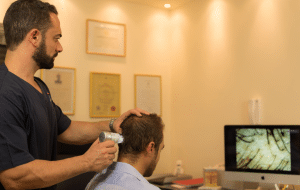
Accurate measurements are obtained using the specialized HR2 Proscope electronic microscope, equipped with the advanced Aptina™ imaging system. This imaging system offers extensive visualization adjustments, ensuring exceptional clarity and real pixel flow at higher resolutions. To put it simply, it can magnify areas smaller than a quarter of a millimeter with 100% clarity, allowing for precise measurements in the donor region. The results of these measurements, along with the clinical evaluation of hair thinning, the availability of hair follicles in the donor area, and the patient’s specific requirements, guide the selection of the most suitable technique.
The subsequent step before we proceed with the hair transplant using the FUE technique involves designing the procedure, incorporating the aforementioned factors alongside the patient’s facial characteristics, to achieve a completely natural and densely packed outcome.

The Coverage Value calculation
Density and thickness of the hair are 2 important criteria to go ahead with a hair transplant using the FUE technique, thus we need to standardize their measurement. Coverage value calculation using a specially designed software give us a good standard for measuring recipient area coverage but also avoiding donor depletion especially in those cases where the highest number of follicular units are needed.
Using several tools like microscopic cameras and densitometers, and sophisticated algorithms we can process, evaluate, quantify, and measure with substantial accuracy the total number of follicular units to be extracted from the occipital, parietal and temporal areas.
Measurements of the FUE donor and recipient areas before the hair transplant using the FUE Technique
Counting the hair follicles in each area, gives us precious data, for example, the exact follicular density per square centimeter, the number of hair follicles per square centimeter, how many hairs we have and the most important parameter, the ratio of hair per follicular unit.
In a hair Transplant using the Fue Technique, it’s paramount for us to know exactly how many hair follicles we can harvest from each sub-area of the entire donor area, in order to extract the best hair follicles possible, meaning, the multi-hair follicles. And all these without leaving the donor area overharvested and sparse, by extracting too many grafts.
It is not easy at all to measure the head’s surface since it is a three-dimensional structure and has curvature on all 3 axes. But we need to have an accurate measurement of the curvature to calculate precisely how many hair follicles we need and where to implant them for optimal effect.
The Science Behind Hair Transplant with FUE Technique: Precision and Expertise
To sum up, before the hair transplant using the FUE Technique, first we measure the surface of the donor area, then we calculate the density and details of the follicles and hairs in each part of the donor area, using specialized software. Then we measure the surface of the recipient area. Lastly, in order to have the most efficient and detailed data and the most accurate results, we measure the average caliber of the hair in each of the sub-areas of the donor area.
With this last step of measuring the hair caliber, we have all the data that we need in order to calculate accurately, both the coverage at the recipient area, according to the number of grafts we will implant, but also, we can calculate the number of hair follicles we can safely harvest from the donor area, so that we won’t leave it depleted. The donor area should never look sparse, and the recipient area should be as dense as it gets with the same number of hair follicles.
Dr. Anastasakis personally takes responsibility for evaluating the grafts from the donor area, creating recipient sites in the recipient area, and supervising all the procedures performed by the nursing staff before operating a hair transplant using the FUE technique.
Hair Transplant Using the FUE Technique: An experienced and dedicated-only-to-hair-transplant Nursing Team
There have been instances where patients who underwent hair transplant using the FUE technique describe a procedure conducted by one or at most two individuals. However, the disheartening aspect of these accounts is that none of them were medical doctors!
At Anastasakis Hair Clinic, the nursing team is dedicated exclusively on hair transplant. In addition to their extensive experience, they continuously update their vast knowledge with the latest scientifically approved developments in the field. What sets them apart is their specialized expertise.
Specifically, for hair transplant using the FUE technique, and depending on the number of follicular units, each procedure is supported by 6-10 or even more nurses in the case of a hyper-mega session, alongside the overseeing hair surgeon.
Once the extraction of follicular units from the donor area is completed, Dr. Anastasakis takes charge of creating recipient sites in the recipient area. The harvested follicular units are meticulously prepared using specialized stereomicroscopes like Mantis Vision, ensuring they remain immersed in a nourishing and energetically optimized solution within temperature-controlled cooling chambers.
Subsequently, during a hair transplant using the FUE technique the nursing staff skillfully implants the grafts into these recipient sites, utilizing specially designed tools that facilitate swift placement while minimizing trauma to the follicular units.
The Power of Advanced Tools Ensures Optimal Hair Transplant
When it comes to repairing something, would you opt for someone equipped with just a hammer and a screwdriver, or someone who possesses extensive knowledge and a comprehensive tool kit? The latter choice seems preferable. The same rationale applies here as well.
The tools employed by the medical team are state-of-the-art and highly advanced. These cutting-edge tools guarantee minimal donor and recipient area trauma, while ensuring flawless graft placement without any mechanical damage in the recipient area.
Extraction of Follicular Units from the Donor Area in Hair Transplant using the Fue Technique
The extraction process of follicular units from the donor area involves the use of FUE titanium manual punches or mechanical MAMBA punches (Trivellini “flared” and “edge-out”), which are regularly changed to accommodate variations in skin hardness and ensure optimal incision conditions. Additionally, supplementary or alternative punches such as Harris S.A.F.E™ hexagonal punches can also be employed. The diameter of the punches ranges from 0.7mm to 0.9mm, depending on the size of the follicular unit grafts.
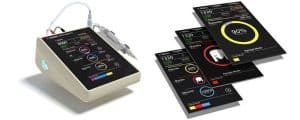
In accordance with the guidelines set by ABHRS and ISHRS, the maximum daily yield of follicular units is approximately 2000 to minimize graft trauma resulting from surgical fatigue. To prevent excessive cumulative trauma to the scalp, the maximum number of follicular units extracted per case is limited to 3500-4500 over a span of two consecutive days.
During the hair transplant using the FUE technique, the follicular units are meticulously harvested from the donor area within the safe donor zone. This approach ensures a minimal visible impact on the donor site, with the collection points strategically dispersed and not prominently noticeable, especially when the hair is trimmed to a shorter length. Subsequently, the process of donor area wound closure will be discussed.
Achieving Maximum Graft Survival with Recipient Site Creation
After the extraction of follicular units, the next step involves the creation of recipient sites in the recipient area. The sites generated range in width from 0.8mm to 1.0mm, utilizing the “Lateral Slit” technique to ensure optimal coverage and a natural appearance.
To achieve both maximum graft survival and aesthetic results in a hair transplant using the FUE technique, a high-density placement of 40-50 follicular units per square centimeter is implemented. This density allows for a dense and visually pleasing outcome while also providing sufficient space for the healthy growth of each graft. Subsequently, the grafts are placed into these pre-existing recipient sites using gentle surgical micro-forceps or blunt implanters.
Follicular Units viability and sustainability
Achieving optimal outcomes in hair transplant using the FUE Technique relies heavily on ensuring the sustainability of grafts. To accomplish this, Anastasakis Hair Clinic follows a specialized protocol for preserving grafts while they are outside of the body. This protocol incorporates specific cooling stations that maintain a consistent temperature of 6°C for the grafts, along with the utilization of HypoThermosol solution and 10% liposomal ATP® to preserve their viability until implantation.
By adhering to this principle, which emphasizes successful graft preservation and subsequent growth, the clinic demonstrates its commitment to successful hair transplant: “We successfully preserved and implanted 10 follicular units from the donor area, and all 10 of them are growing naturally!”
Hair Transplant Using the FUE Technique at Anastasakis Hair Clinic: The Journey of Regrowth
It is widely recognized that the final outcome of a hair transplant using the FUE technique takes approximately one year to fully manifest. However, it’s important to note that waking up one day to a head full of hair is not an immediate occurrence. For individuals who place their trust in Anastasakis Hair Clinic, the regrowth process begins as early as the second month, with noticeable results becoming apparent within the initial four months. The regrowth of new hair continues gradually, culminating in the complete outcome around the twelve-month mark.
To ensure comprehensive monitoring of the hair transplant progress, Anastasakis Hair Clinic follows a specific follow-up examination protocol. These examinations occur at intervals of 1 day, 3 days, 5 days, 8 days, and 15 days, as well as 1 month, 9 months, and 12 months post-transplantation. These follow-up examinations hold great significance for both the patient and the physician, providing a clear overview of the regrowth journey.
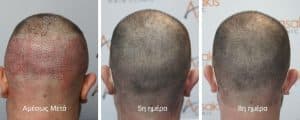
Understanding Hair Shedding after Hair Transplant using the FUE Technique
You may have heard about the initial shedding of hair in the early stages following the procedure. This is considered a normal and expected process. After having a hair transplant, hair shedding is noticeable after a few weeks. This shedding is part of the hair growth cycle, and the transplanted hair that grow within the hair follicle, will begin to regrow in a few weeks. It is important to understand and not confuse this normal hair shedding, which usually occurs after the procedure, with shock loss.
If all the steps of the hair transplant using the Fue technique procedure are performed correctly and according to the guidelines of modern hair transplantation, rest assured that the hair grafts will not experience any shock! An experienced physician, along with a specialized technicians’ team, will ensure that your grafts remain undisturbed, and the entire process is carried out with minimal disruption to them.
The Unique Protocol of Anastasakis Hair Clinic: Elevating the Standards of Hair Transplant
Anastasakis Hair Clinic implements a specific protocol throughout the entire process of hair transplant using the FUE technique or any other methods, starting from the initial consultation to the final one-year follow-up examination. This comprehensive postoperative protocol includes continuous monitoring, detailed instructions, laser sessions, and a personalized hair-kit containing essential supplies immediately after the hair transplant. Furthermore, a designated member of the nursing staff is assigned to each patient, ensuring diligent observation and prompt communication with the physician regarding their progress.
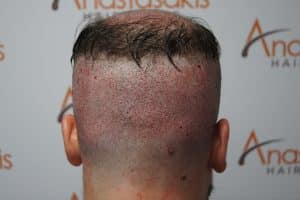
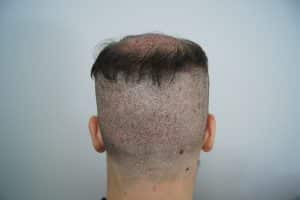
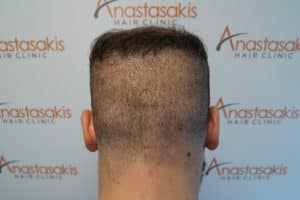
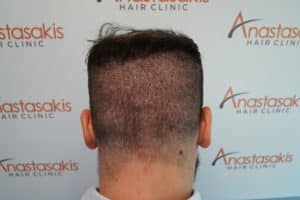
To facilitate rapid healing of both the donor and recipient areas, as well as expedite the growth of new hair, Dr. Anastasakis employs specific pharmaceutical formulations and follows precise procedures. By utilizing the 10% liposomal ATP® solution for the recipient area and if needed in conjunction with PRP therapy and Capillus 272 OfficePro LLLT (Low Level Laser Therapy) sessions, optimal healing of the donor and recipient areas is ensured, leading to faster hair graft growth.
All these services are provided by Anastasakis Hair Clinic without any additional charges, as they are integral components of the procedures and services aimed at achieving quicker and superior results in hair transplant using the FUE Technique.
What should someone anticipate after undergoing a hair transplant using the FUE technique?
When the hair transplant using the FUE Technique is performed by a skilled physician and their experienced team, there are two key expectations:
A regrowth rate of over 98% and minimal trauma to the donor area. Throughout the entire process, from pre-operative consultations to post-operative care, the doctor and the dedicated nursing team will provide continuous support and conduct regular check-ups.
The ultimate outcome of the hair transplant using the FUE technique will be a dense and entirely natural-looking result, leaving no discernible signs of undergoing a surgical procedure.
Is FUE hair transplant the right choice for you? If you have any inquiries regarding the cost of a hair transplant, feel free to schedule an appointment online, and our team will guide you accordingly!



